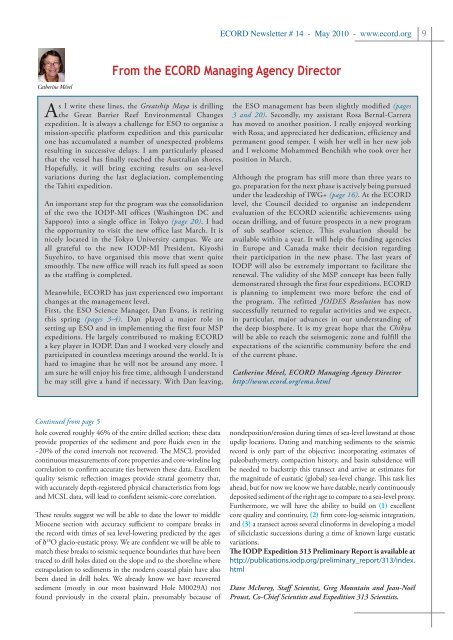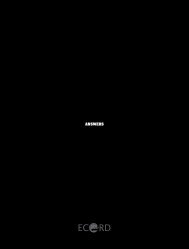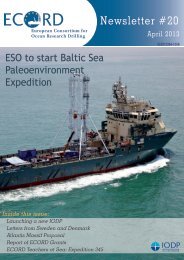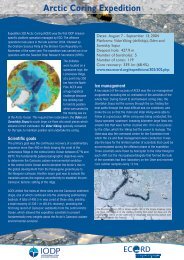14 - European Consortium for Ocean Research Drilling
14 - European Consortium for Ocean Research Drilling
14 - European Consortium for Ocean Research Drilling
- No tags were found...
Create successful ePaper yourself
Turn your PDF publications into a flip-book with our unique Google optimized e-Paper software.
ECORD Newsletter # <strong>14</strong> - May 2010 - www.ecord.org 9From the ECORD Managing Agency DirectorCatherine MévelAs I write these lines, the Greatship Maya is drillingthe Great Barrier Reef Environmental Changesexpedition. It is always a challenge <strong>for</strong> ESO to organise amission-specific plat<strong>for</strong>m expedition and this particularone has accumulated a number of unexpected problemsresulting in successive delays. I am particularly pleasedthat the vessel has finally reached the Australian shores.Hopefully, it will bring exciting results on sea-levelvariations during the last deglaciation, complementingthe Tahiti expedition.An important step <strong>for</strong> the program was the consolidationof the two the IODP-MI offices (Washington DC andSapporo) into a single office in Tokyo (page 20). I hadthe opportunity to visit the new office last March. It isnicely located in the Tokyo University campus. We areall grateful to the new IODP-MI President, KiyoshiSuyehiro, to have organised this move that went quitesmoothly. The new office will reach its full speed as soonas the staffing is completed.Meanwhile, ECORD has just experienced two importantchanges at the management level.First, the ESO Science Manager, Dan Evans, is retiringthis spring (pages 3-4). Dan played a major role insetting up ESO and in implementing the first four MSPexpeditions. He largely contributed to making ECORDa key player in IODP. Dan and I worked very closely andparticipated in countless meetings around the world. It ishard to imagine that he will not be around any more. Iam sure he will enjoy his free time, although I understandhe may still give a hand if necessary. With Dan leaving,the ESO management has been slightly modified (pages3 and 20). Secondly, my assistant Rosa Bernal-Carrerahas moved to another position. I really enjoyed workingwith Rosa, and appreciated her dedication, efficiency andpermanent good temper. I wish her well in her new joband I welcome Mohammed Benchikh who took over herposition in March.Although the program has still more than three years togo, preparation <strong>for</strong> the next phase is actively being pursuedunder the leadership of IWG+ (page 16). At the ECORDlevel, the Council decided to organise an independentevaluation of the ECORD scientific achievements usingocean drilling, and of future prospects in a new programof sub seafloor science. This evaluation should beavailable within a year. It will help the funding agenciesin Europe and Canada make their decision regardingtheir participation in the new phase. The last years ofIODP will also be extremely important to facilitate therenewal. The validity of the MSP concept has been fullydemonstrated through the first four expeditions. ECORDis planning to implement two more be<strong>for</strong>e the end ofthe program. The refitted JOIDES Resolution has nowsuccessfully returned to regular activities and we expect,in particular, major advances in our understanding ofthe deep biosphere. It is my great hope that the Chikyuwill be able to reach the seismogenic zone and fulfill theexpectations of the scientific community be<strong>for</strong>e the endof the current phase.Catherine Mével, ECORD Managing Agency Directorhttp://www.ecord.org/ema.htmlContinued from page 5hole covered roughly 46% of the entire drilled section; these dataprovide properties of the sediment and pore fluids even in the~20% of the cored intervals not recovered. The MSCL providedcontinuous measurements of core properties and core-wireline logcorrelation to confirm accurate ties between these data. Excellentquality seismic reflection images provide stratal geometry that,with accurately depth-registered physical characteristics from logsand MCSL data, will lead to confident seismic-core correlation.These results suggest we will be able to date the lower to middleMiocene section with accuracy sufficient to compare breaks inthe record with times of sea level-lowering predicted by the agesof δ 18 O glacio-eustatic proxy. We are confident we will be able tomatch these breaks to seismic sequence boundaries that have beentraced to drill holes dated on the slope and to the shoreline whereextrapolation to sediments in the modern coastal plain have alsobeen dated in drill holes. We already know we have recoveredsediment (mostly in our most basinward Hole M0029A) notfound previously in the coastal plain, presumably because ofnondeposition/erosion during times of sea-level lowstand at thoseupdip locations. Dating and matching sediments to the seismicrecord is only part of the objective; incorporating estimates ofpaleobathymetry, compaction history, and basin subsidence willbe needed to backstrip this transect and arrive at estimates <strong>for</strong>the magnitude of eustatic (global) sea-level change. This task liesahead, but <strong>for</strong> now we know we have datable, nearly continuouslydeposited sediment of the right age to compare to a sea-level proxy.Furthermore, we will have the ability to build on (1) excellentcore quality and continuity, (2) firm core-log-seismic integration,and (3) a transect across several clino<strong>for</strong>ms in developing a modelof siliciclastic successions during a time of known large eustaticvariations.The IODP Expedition 313 Preliminary Report is available athttp://publications.iodp.org/preliminary_report/313/index.htmlDave McInroy, Staff Scientist, Greg Mountain and Jean-NoëlProust, Co-Chief Scientists and Expedition 313 Scientists.







